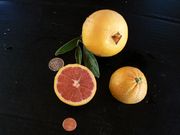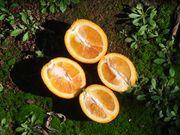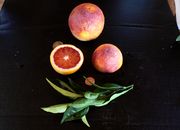Blood oranges
Common blood oranges
In
addition to the pinkish and bright red colours formed by lycopenes in
light blood oranges the true
blood oranges are often at least partially pigmented by
the fully dark shades of anthocyanins.
A typical blood orange has multi-coloured flesh ranging from strongly
pigmented areas to
spots without any 'blood'. The juice of a common blood orange is
usually only medium
red due to the many light areas inside the fruit. The degree
and darkness of
the colouration of course vary greatly from year to year
according to climatic and other growing conditions.
|
|
|
| LAT |
Citrus ×
sinensis
Sanguinello Group |


Sanguinello

Sanguinello Moscato

Sanguinello Moscato di Cuscunà

Sanguinello a Pignu
|
| |
Citrus × sinensis 'Sanguinello'
Citrus × sinensis 'Sanguinello
Moscato'
Citrus
×
sinensis 'Sanguinello
Moscato di
Cuscuna'
Citrus
× sinensis
'Sanguinello a Pignu'
|
|
Sanguinello Group
Sanguinello
is an old Italian blood orange variety of unknown origin. By a statute
"Arancia rossa di Sicilia" (Sicilian blood orange) is a Protected
Geographical Indication and the oranges can be grown in a strictly
limited area on the eastern side of Sicily, south of Mount Etna. The
only varieties allowed are Sanguinello, Tarocco
and Moro with
their most common
derivatives.
Depending on growing conditions the Sanguinello varieties can sometimes
have very little pigmentation
on the skin while being reasonably well-coloured inside.
All Sanguinellos are sweeter, less acidic and more consistent
than Moro, but
cannot reach the superior flavour of the mature Tarocco varieties.
Sanguinello
(Sanguinello Comune) has long
been one of the most important blood oranges of Sicily.
Fruit
are medium-sized, seeds few or none. Orange-coloured at maturity,
washed
with red. Rind medium-thick, moderately tough and adherent, and
moderately to strongly pebbled. Flesh rather deeply red pigmented at
maturity (more so and earlier than rind), juicy, pleasantly
flavoured. Tree of medium vigour and size, productive.
Disambiguation:
Sanguinello should not be confused with Sanguinelli,
a
Spanish deep blood orange that is of no relation.
Sanguinello
Moscato is probably one of the most highly
reputed blood oranges
in
Europe. It grows on the slopes of Mount Etna in Sicily where it is one
of the principal varieties. Considered a superior cultivar it is known
in the export trade as 'Paterno'
orange,
after
a nearby town. The tree is vigorous, large, symmetrical in form; very
productive with most of the crop borne inside, where it is protected
against climatic vicissitudes and uniformity in pigmentation is
favoured.
Sanguinello Moscato
di Cuscunà
The rind of Sanguinello Moscato di
Cuscunà is thinner and
smoother than the skin of the other three Sanguinellos. Cuscunà is an
earlier variety maturing in January whereas the others are later
and mature in February-March.
Sanguinello a Pignu
The origin of Sanguinello a Pignu is uncertain. We
know that it is a Sicilian variety, like so many other blood oranges.
It bears few of the characteristics of other Sanguinello varieties so
it may be related in name only. Sanguinello a Pignu seldom
gets any
real pigmentation either on the skin or in its flesh. In highly
suitable conditions Sanguinello a Pignu develops red specks both on the
rind and inside and in this respect it resembles the light blood
oranges like Washington
Sanguine
(the Sanguine Grosse
Ronde of many Internet articles). However, the taste
remains that of a sweet orange and lacks the typical flavour of blood
oranges.
|
| ENG |
Sanguinello,
Sanguinello Moscato,
Sanguinello Moscato di Cuscunà and Sanguinello Pignu blood oranges.
|
| FRA |
Oranges
Sanguines Sanguinello,Sanguinello Moscato,
Sanguinello Moscato di Cuscunà et Sanguinello a Pignu.
|
| Photos |
|
(1-2,5) © Jorma Koskinen
(3) © UC Riverside
(4) © C. Jacquemond
/ INRA
|
| |
|
|































































